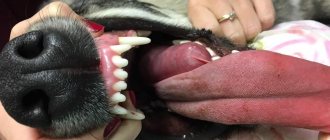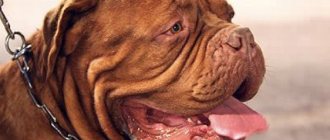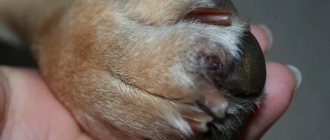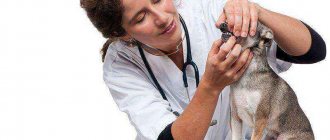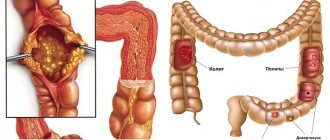It's easy and interesting to communicate here. Join us!
so take a thermometer and measure it, the temperature in the morning cannot be determined by the stomach and nose.
The body temperature of dogs is higher than that of people (37-39 degrees - depends on age and breed), if the nose is dry and hot, it means it is sick. It’s not clear what the girl has to do with it; if we’re talking about a dog, then they are females or males, and boys and girls are human children, but they’re not cuties.
My dog always seems hot to me - her normal temperature is 37.6-38.2 degrees, mine is significantly lower. And her nose is always dry - she is always digging for something in her bed and wiping the mucus on rags. When it seems that the dog has a temperature, take a thermometer and measure this temperature. If she's approaching 39, then it's time to run to the vet.
Take your temperature. I hope you know how? And the dog’s nose may be hot when he just woke up, his tummy is hot. This is not an indicator, but check it anyway.
A dry and hot nose is NOT at all an indicator of an unhealthy dog. Hot, dry air, the dog just sleeping are the most common causes of a dry nose. You need to measure the dog's temperature rectally and only draw some conclusions based on this. Besides the fact that the dog seems hot to you, are there any other symptoms?
Whatever it seems, take a thermometer and measure your temperature rectally.
A dog's nose is an indicator of the pet's condition
When you touch the nose of a healthy puppy or adult dog, you will probably feel that it is cold and wet. There is nothing unusual about this; unlike in humans, a wet dog’s nose signals the complete health of your pet. But what can the nose tell if it is dry, warm or has an unusual appearance? Why is a dog’s nose wet, and why does it suddenly become hot and dry? Let's talk about this in more detail.
Healthy dog nose
So, a dog who is in good health has a wet and cold nose, which he joyfully pokes at you, inviting you to play or demonstrating his affection. But why is it wet? What are the reasons?
There are several theories to explain this interesting fact. Which one is the most famous? It belongs to zoologist Knut Schmidt-Nielsen. After conducting a scientific experiment, the scientist came to the conclusion that the dog does not have sweat glands. That is why a wet olfactory organ saves the animal from overheating.
If a pet breathes frequently, sticking out its tongue, it cools down and the nose directly participates in this, since droplets of liquid evaporate faster through the nose. Thus, the nasal glands actively participate in the process of heat exchange in a healthy animal. Normally, the dog should not experience any problems in this matter. In addition, the mucus coming out of the nostrils moistens the sensitive earlobe, and while remaining wet and cold, the nose captures odors well. This may be why dogs often rely on their sense of smell, unlike cats, who have keen vision.
If your nose is dry
It is believed that if a dog's nose is deprived of moisture, it means he is sick. But does earlobe dryness always indicate health problems? What are the true reasons for a dog's warm nose?
The second reason is all
Source
The dog has a dry nose: we understand the causes and additional symptoms
Probably every owner, having noticed something wrong in the dog’s behavior, first of all feels its nose, cold and wet - everything is fine, dry or hot - something is wrong. In principle, the premise is correct, a dog’s nose is a kind of indicator of well-being. Let's say your nose is dry and hot, what should you do next? Observe? Run to the clinic? Treat yourself, if so, then for what? First, you need to understand that there can be a lot of reasons, both harmless and dangerous. We don’t panic and figure out why the dog has a dry nose, what you can do on your own and in what cases you can’t wait.
A dry and warm nose is not a death sentence
Where the tradition of determining a dog’s condition by feeling its nose came from is not known, only one thing is clear: either thermometers were rare in those days, or veterinary clinics did not yet exist. First, let's figure out why a wet and cold nose is the norm. The entire nose of a dog, both inside and out, is covered with a mucous membrane that secretes moisturizing secretions. Functionally, the pet uses its nose not only for smell; the wet surface reacts to the slightest air fluctuations and drafts. The nose of a sleeping wild dog monitors the possible approach of an enemy - this is one of the ways of survival. It is customary to “diagnose” high fever, viral diseases, and a weak immune system using the nose.
Personal characteristics or age. Puppies often “sin” with a warm nose, if the rest of the dog’s condition is not alarming, you do not suspect an acute reaction to the vaccination - rest easy, the “child” will grow up and everything will pass. Some dogs have a special nose structure, a “passive” mucous membrane, and a slow metabolism. These pets have a warm or dry nose throughout their lives.
Source
Causes of muzzle swelling in dogs
The occurrence of swelling is explained by external or internal factors. The former include allergens, mechanical damage and bacterial infections, and the latter include neoplasms of varying degrees of malignancy, non-infectious diseases of the eyes, heart and kidneys.
Eye problems
Eye injuries and diseases are often accompanied by itching and irritation of the conjunctiva. Due to active scratching, damage to neighboring tissues occurs, resulting in their swelling.
The most common causes of ophthalmic pathologies include:
- foreign bodies that injure the cornea;
- conjunctivitis of various etiologies, accompanied by swelling and redness of the eye mucosa;
- blepharitis, characterized by unilateral or bilateral inflammation of the edges of the eyelids.
It is not so difficult to distinguish the listed reasons from each other. The presence of a stuck blade of grass can be noticed visually or determined by incessant tearing.
With conjunctivitis, the color of the mucous membrane resembles ripe raspberries, and purulent discharge often appears from the affected eye. If the problem is blepharitis, then at the site of inflammation, eyelashes and hairs begin to fall out, and the skin underneath becomes noticeably rougher.
Dental diseases
If your dog's face is swollen on only one side, look into its mouth. It is highly likely that you will find inflamed gums and signs of caries, stomatitis or other dental diseases there.
Due to toothache, the animal will refuse to eat and show apathy. When flux forms, symptoms may be supplemented by fever.
Allergies: to insect and snake bites, to food, to medicines, to vaccinations
Swelling is one of the main symptoms of an allergic reaction. The most common allergens include:
- snake bites, stinging and blood-sucking insects;
- products rich in chemicals (broiler chickens);
- plant pollen;
- medications, including vaccines administered during vaccination;
- shampoos and household chemicals.
In most cases, in addition to a swollen face, the affected animal experiences severe itching and redness of the eyes. The speed at which symptoms appear depends on the amount of allergen that has entered the body and the strength of the immune system.
Neoplasms, abscesses, oncology
Neoplasms on a dog's face can be a tumor or an abscess of varying degrees of malignancy. In the first case, they are often localized in the throat or oral cavity, accompanied by:
- swelling of the eyes;
- the appearance of an unpleasant odor from the mouth;
- bleeding and purulent discharge;
- difficulty swallowing food and water;
- asymmetry of the muzzle.
The development of an abscess is caused by bacteria entering an unhealed wound. What distinguishes it from a tumor is the obligatory presence of severe pain. All other symptoms often coincide, so only a veterinarian can make an accurate diagnosis.
Swelling due to heart or kidney problems
In cardiac and renal pathologies, there is a slowdown in capillary blood flow in the pulmonary circulation and impaired outflow of lymphatic fluid. Due to the difference in internal pressure, both complications lead to tissue swelling. You can suspect something wrong in the functioning of the internal organs by difficulty breathing and difficulty urinating (incontinence or urinary retention).
Injuries
Another reason why a dog's muzzle may become swollen is injury. In this case, the swelling that appears is explained by a hematoma resulting from a fight, an unsuccessful game or a fall. Be sure to examine your pet for bites, lacerations, or scratches. Such damage is fraught with infection.
Infections
Insect bites and injuries are often complicated by abscesses. Bacteria that penetrate through damaged skin cause an increase in body temperature and acute pain.
Without timely treatment, the infection can spread to neighboring tissues and organs, so if these symptoms appear, the dog should be scheduled for examination at the nearest veterinary clinic.
A dog's nose is an indicator of the pet's condition
When you touch the nose of a healthy puppy or adult dog, you will probably feel that it is cold and wet. There is nothing unusual about this; unlike in humans, a wet dog’s nose signals the complete health of your pet. But what can the nose tell if it is dry, warm or has an unusual appearance? Why is a dog’s nose wet, and why does it suddenly become hot and dry? Let's talk about this in more detail.
Healthy dog nose
So, a dog who is in good health has a wet and cold nose, which he joyfully pokes at you, inviting you to play or demonstrating his affection. But why is it wet? What are the reasons?
There are several theories to explain this interesting fact. Which one is the most famous? It belongs to zoologist Knut Schmidt-Nielsen. After conducting a scientific experiment, the scientist came to the conclusion that the dog does not have sweat glands. That is why a wet olfactory organ saves the animal from overheating.
If a pet breathes frequently, sticking out its tongue, it cools down and the nose directly participates in this, since droplets of liquid evaporate faster through the nose. Thus, the nasal glands actively participate in the process of heat exchange in a healthy animal. Normally, the dog should not experience any problems in this matter. In addition, the mucus coming out of the nostrils moistens the sensitive earlobe, and while remaining wet and cold, the nose captures odors well. This may be why dogs often rely on their sense of smell, unlike cats, who have keen vision.
If your nose is dry
It is believed that if a dog's nose is deprived of moisture, it means he is sick. But does earlobe dryness always indicate health problems? What are the true reasons for a dog's warm nose?
How to Prevent Heatstroke in a Dog
- Never leave your dog alone in a parked car , especially on warm or hot days. The car can quickly heat up to a temperature that threatens the life and health of the animal. Remember that leaving your dog in the car with the window cracked is not an option. A tilted window does not prevent the car from heating up. On hot days, it is best to leave the dog in a cool house with current access to drinking water.
- Avoid walking on hardened or hot surfaces . Walking on hot surfaces can burn our dog's sensitive paws. Burns are not the only threat, because heating the paws can very quickly lead to overheating of the dog’s entire body. Also, do not let your dog lie or rest on hot surfaces for too long.
- Always carry drinking water for your dog . This is very important especially when walking, because in addition to overheating, the dog can also very quickly become dehydrated.
- Try planning your walks in the morning or evening when the temperature is not very high. If you decide to go for a walk during the day, try to spend most of the time in the shade and do not overdo your pet's training and exercise. Even on cloudy summer days, trying too hard can lead to heatstroke.
The puppy has a hot nose, what should I do?
If a puppy's nose is hot, what does it mean?
Normal temperature in dogs is 37.5 - 39 degrees (in puppies 38 - 39.3 degrees). A rise in temperature above 39 degrees may indicate the onset of a pathological process. Body temperature rises during physical activity, when an infection enters the body, or during stress. A change in normal temperature can also be caused by weather that is too hot or too cold. Memorize or write down your dog's normal temperature. The most suitable time to measure is 7 am and 11 pm.
To measure the temperature, shake the thermometer (use the most common medical thermometer). make sure that the mercury has dropped to the lower mark, lubricate the thermometer with Vaseline or cream, then, carefully rotating, insert 4-5 cm into the rectum. At the same time, the dog should be supported under its belly so that it does not sit down - otherwise the thermometer may break. The thermometer is held for 5 minutes. Then remove the thermometer, clean the feces and wash with warm water and soap. Disinfect the thermometer after each use.
If the temperature is above 39.1°C, then you should contact your veterinarian to find out the reasons for its rise. If the temperature is below 37.5°C, then you should keep the animal warm and call a veterinarian immediately.
Why does my dog have a dry nose?
This is partly true. It is important at what point it was noticed that the dog has a dry nose, as well as whether other symptoms of any diseases are present. If the dog is sleeping at this moment or has just woken up, then a dry nose is normal. The nose can also be dry after serious physical exertion, in extreme heat or cold. If the nose is not moisturized during moments of quiet wakefulness, then this may indeed signal health problems.
Why does a dog have dry hot or cold?
Source
How can you tell if your dog is sick?
Those who know their pet well will quickly recognize deviations from normal condition or behavior. There is no need to immediately run to the veterinarian, since many of the symptoms individually can be a manifestation of mild illness.
Rapid breathing - often at a rapid pace - and sticking out the tongue are not signs of the disease. The dog does not have sweat glands. Therefore, when tired or thirsty, she cannot regulate her body temperature by evaporating moisture from its surface. She replaces this with rapid breathing.
Vomiting by itself, without other symptoms of the disease , is not a sign of illness. A dog can easily vomit, especially after greedily eating food. What is torn out is often quickly devoured with great eagerness.
If a dog creeps restlessly, with its head hanging low, or it begins to choke, these are signs of impending vomiting and a sign for the owner to quickly take it outside.
A dog's dry, hot nose If a dry hot nose appears after sleep or tiring work, on very dry days, after digging in dry warm soil, and sometimes in a female dog in heat, then we should check after a while whether the nose has become cold and wet, like a healthy dog. If there is a suspicion of illness, we measure the temperature. To do this, the tip of the thermometer, lubricated with cream, is inserted 3 cm into the anus and left there for 3-4 minutes. During this procedure, which is carried out by the owner-leader, the dog must be held tightly. A dog's normal temperature ranges from 37.5 to 39.0 degrees. If the temperature is above 39 degrees, you should definitely contact a veterinarian. To recognize the disease and treat it correctly, the help of a professional is necessary. Self-medication is unacceptable!
Discharge from the eyes and nose , purulent pimples on the abdomen, a hot and dry nose, lack of appetite, but there is strong thirst and fever - immediately run to the doctor, as these are signs of distemper. Most dogs infected with distemper cannot be saved. The best preventative measure is a vaccination, which is given at the 6th week of life and repeated every year.
Contact your veterinarian immediately if your dog exhibits the following symptoms:
- moodiness, irritability, moodiness,
- the need to gnaw and chew inedible objects (furniture, boots, soil, stones, bedspreads, etc.) with a complete lack of appetite,
- response to slight light,
- swinging gait,
- constant desire to bite someone,
- attempts to escape, barking and howling;
- at the last stage the backside and lower jaw are taken away.
These are signs of rabies!!!
Rabies in dogs (like all animals) is incurable, so they have to be euthanized. If a person is suspected of having rabies, he must undergo a course of Pasteur vaccinations.Preventive measures: in the dog-excluded area, follow all regulations; under no circumstances should your dog be allowed to run alone through fields and forests. During the prohibited time, limit the dog’s movement, if possible, in the immediate vicinity of the house. Keep the dog on a leash and prevent it from meeting other dogs.
Severe itching , accompanied by constant scratching, suggests scabies. Scabies is caused by a type of mite and can result in bare, bleeding spots on the body. Treatment is prescribed by a veterinarian. All items and dog bedding must be thoroughly disinfected.
When the conjunctiva is inflamed or catarrh occurs, purulent or mucous discharge comes from the eyes. It is often caused by drafts. In most cases, washing with a 2% aqueous solution of boric acid or filtered chamomile tincture can achieve a quick recovery. In addition, with such discharge from the eyes, it is necessary to measure the temperature, because this is one of the symptoms of the plague. If in doubt, be sure to contact a veterinarian.
If your dog frequently shakes his head to the point where his ears start to pop, this could be a sign of an ear disease . Read more information in the article “Healthy ears: treating otitis media.” Dogs with long, furred ears are more susceptible to ear diseases than those with short ears. With regular ear cleaning, this disease rarely occurs. If it does start, then you need to consult a veterinarian about the necessary washings. Many dachshunds love to flap their ears without any illness.
Frequent and drop-shaped urination is a sign that the bladder is congested. The reasons may be: lying on cold stones or a long, motionless wait for the owner on the street, excessively cold bedding. In this case, the dog can be treated with warm compresses and infusions of bearberry leaves.
For constipation , we add dry yeast to the dog’s food or give fresh brewer’s yeast in a piece, or in extreme cases, a mild laxative. But brewer's yeast cannot be mixed with food, otherwise it may ferment. Yeast stimulates the intestinal flora, thus restoring normal digestion.
For diarrhea, we give our dog animal charcoal or sage infusion. We buy animal charcoal in factory packaging and mix it into food. One day of fasting will not be amiss. If diarrhea occurs frequently, contact your veterinarian. Read the articles “Diarrhea (diarrhea) in dogs”, Enterocolitis in dogs
Intestinal blockage is manifested by vomiting in the dog, a complete lack of digestion and cramps (spasms) of painful origin. It can occur when foreign bodies are ingested, such as synthetic sausage skins, pebbles, pieces of rubber, and the like.
Unnaturally frequent thirst in a dog, while it loses weight and develops chronic eczema on its back, may indicate kidney disease. For treatment we contact a veterinarian. You can avoid this disease if you do not add salt and spices to your dog's food, and also take it outside regularly.
A severe, sudden illness suggests poisoning. We immediately take the dog to the veterinarian. If this is not possible, then we give her an emetic. To do this, mix 3 grams of sugar and, depending on the height of the dog, from 0.05 (dwarf breeds) to 0.3 grams of tartar emetic into a ball of white bread. If the dog does not vomit, then repeat this procedure after a while.
Hind limb paralysis occurs predominantly in dogs with long backs and prominent hindquarters. Treatment is prescribed by a veterinarian.
Literature used/> Manfred Koch-Kostersitz. 400 tips for dog lovers Leningrad, MEGAPOLIS EXPRESS, 1991,90 pages
What causes a dog's stomach to growl?
A dog is man's friend. And if suddenly your pet’s health or well-being deteriorates, then you will probably worry about this. And sometimes even the most seemingly harmless symptoms can cause fear and anxiety. What could a rumbling stomach mean?
Rumbling in the stomach, especially loud and prolonged, is simply impossible not to notice. With this symptom, gurgling sounds occur coming from the pet’s abdominal cavity. They resemble boiling or pouring liquid and are clearly audible to others.
There may be no other warning signs, meaning the dog will feel quite normal, be active, eat and behave as usual. But sometimes other accompanying symptoms occur: flatulence, pain in the abdominal cavity (the animal can respond to them by whining, trying to hide in a corner), drowsiness, decreased activity, diarrhea or vomiting, loss of appetite or complete refusal to eat, as well as increased body temperature.
Why does a dog's stomach growl? The reasons for such a symptom can be very diverse, and both frivolous and very dangerous. Here are some of them:
Poor nutrition. While some dogs easily digest any food, others have a rather weak gastrointestinal tract and react sharply to even the slightest errors. Digestive disorders can be caused by foods not intended for pets, for example, sweets, fatty, fried, spicy, smoked, processed foods, fast food, and so on. Also, rumbling can be triggered by foods that cause increased gas formation, for example, cabbage, cucumbers. Among other things, mild indigestion can occur when introducing new foods into the diet or when switching from feed to natural food (or vice versa).
If your pet eats greedily and is very fast
Source
Head diseases in dogs
Author: Maxim Tikhomirov Category: Diseases and treatment
A dear pet can cause a lot of trouble if it injures its head during play or active recreation. The consequences may not be immediately visible, which is why you need to carefully monitor your pet’s behavior after an injury. Causes of head diseases
Active dogs often injure themselves while playing.
Curiosity often pushes them into trouble. By picking up leftover food or showing curiosity about certain objects, man's four-legged friends bring a lot of trouble to themselves and their owner. Since the main source of information for dogs is the sense of smell and touch, the head remains the main affected area. When testing objects for taste or strength, a pet does not calculate the force of compression. This leads to pieces of the broken game object falling into the mouth. All head diseases in dogs can be divided into several groups:
• damage from blows;
• mechanical injuries; • viral diseases; • inflammatory diseases. Each of these groups can be the result of more than one cause. Inflammation can accompany mechanical damage to the tissues of the mouth. You can identify your pet’s illnesses in the early stages by his behavior. Warning signs of diseases are
: • sudden changes in behavior;
• sluggish body; • lack of interest in food, toys, owner; • restless behavior; • uncharacteristic discharge. Each disease has its own symptoms and treatment methods. Common head diseases in dogs Inflammation of the meninges The manifestation of this disease can be a consequence of a head injury. In some cases, this is preceded by an acute viral illness. Some mite pathogens can have a similar effect. The disease has pronounced characteristic features. The main signs of inflammatory processes in the membranes of the brain are
: • lethargic state of the animal;
• fever, hot head; • swelling and redness of the membranes of the oral cavity; • dryness of the mucous membranes of the nose and tongue; • rapid breathing; • lack of consciousness; • paralysis; • if the animal is conscious - a characteristic shaking of the head; • hard dry feces; • almost complete absence of urination. If there are hints of such a serious disease, you should seek the help of a veterinarian. Treatment used Main drugs prescribed:
• belladonna 3;
• aconite 3; • arnica 3 (if the cause was a shock). The dose and frequency of use are prescribed by the veterinarian depending on the severity of the disease. Most often, this dosage does not exceed 5 drops if the substance was sold in solution. If the drugs were sold as dry powder - 5 grains. You can give the medicine:
• by mixing it with broth;
• pressing into the bread crumb; • mixed with oatmeal. In the intervals between taking the medicine, a cold compress must be applied. If the general symptoms are complemented by paralysis, is prescribed
: • Cuprum 3;
• Stramonium 3. Drugs are given several times a day. Epileptic seizures In young dogs, the cause of epileptic seizures may be the change of teeth. Adults suffer from this disease due to
: • damage to the body by helminths;
• incompatibility of the drugs used; • consequences of the disease; • allergic reaction to food; • emotional stress. Epilepsy fails quite clearly:
• loss of consciousness;
• foam release; • convulsive contraction of the limbs; • squealing, barking. During a seizure, the pet loses control over its behavior. Due to lack of consciousness, the animal falls and convulses. A large amount of blood rushes to the head, the pupils dilate, and redness of the cornea is observed. Treatment for epilepsy
The main drugs
are
: • Belladonna 3;
• Arnica 3; • Ignacia 3; • Cuprum 3; • Antimonium. The dosage is prescribed by the treating veterinarian. Most often, the dose is reduced to 5–6 servings in several doses. Food during the treatment period should not contain artificial colors or flavor enhancers. Dietary food is prescribed. Tetanus Damage to an animal's body by tetanus can occur due to several reasons
: • repeated trauma during the recovery period;
• viral diseases; • infections. The animal is completely restrained. His muscles are in a state of constant tone, his jaws are clenched. This causes uneven blood supply to the body organs. Without receiving enough oxygen, organs, especially the brain, malfunction. Treatment options
At the first symptoms, call your veterinarian.
Its efficiency will be the key to your pet’s life. While there is no doctor, the victim needs
: • twilight; • silence; • peace. After analyzing the condition, the doctor will be able to determine the reasons that caused tetanus. Antitetanus serum is administered. If the onset of tetanus was preceded by a wound, the wound is treated. Additionally, sedative injections are given. Droppers with vitamins and glucose are possible.
- Head diseases
- dogs
- illnesses
March 19, 2017| 16:06
Hot belly in the early stages! Who had this happen?
Girls, hello! This is my first pregnancy, 8 obstetric (6 embryonic) weeks. The pregnancy is long-awaited, so I’m very worried about everything, as soon as I go to read information on the Internet, something constantly worries me, and when I read all sorts of horrors, I just give up.
Firstly, I am interested in what body temperature should be during pregnancy? For me, from the first week it stays at 37.1, up to 37.4, sometimes it rises quite sharply in the evenings, jumps, and for example, when you undress or throw off the blanket, it subsides to 37. I do not have any symptoms of inflammatory diseases. At the same time, I constantly feel hot and cold... my legs are freezing, and my stomach is really hot! I especially notice it in the evenings, when I’m lying under the blanket - well, it’s just hot to the touch, as if it’s all 40 in there! All the time there is a feeling that everything will be boiled there. My husband also noticed that I became very hot. I’ll throw off the blanket and the temperature will be normal, even cool, very quickly, but without a blanket I’m cold! At the same time, everyone’s head is like cast iron. This has been going on for over a month now. I read, of course, that in the early stages the TT should be 37.1-37.4, that’s what doctors say, and that hormones influence it in such a way that it should be so... but I also find articles that elevated temperatures cause deformities in the fetus in the early stages!
Should I be afraid of anything? Was your stomach very hot? Have you felt this way? Calm me down, otherwise when I touch such a hot belly, I’m very afraid, I’m scared for the baby. This may all sound stupid to some, but here it is. ))
User comments
Well, I said in advance that it might sound stupid! After all, this is my first pregnancy, so I’m worried, I’m asking! Thanks for the answer and advice!
You need to be careful about the Internet, you will make your baby nervous! Better watch the series chicks and
Source
ZooForum: a dog has a swollen belly – ZooForum
(others can give advice in a PM, indicating that the advice is not given by a veterinarian. But the forum is not responsible for THESE advice.)
bloated belly in a dog bloated belly in a dog with general exhaustion
natafin you definitely need to do an ultrasound of the abdominal cavity, a blood test and a clinical blood test, you may need an x-ray, based on the symptoms that you describe, it is unlikely that the dog has a digestive problem, but a neoplasm of the abdominal cavity must be ruled out. He is better now. just often, but in small portions.
X-ray of the cavity, increased X-ray density of the entire abdominal cavity, the liver is increased in size. (X-ray is not given in hand)
4. For diagnosis, you should now puncture the abdomen and examine the resulting fluid - is it inflammatory, ascites or tumor.
If there is ascites and there is no tumor on the liver ultrasound, examine and treat the heart; if there are tumor cells, do an X-ray of the lungs and, if there are no metastases, a diagnostic laparotomy; if there is pus, install drainages and treat peritonitis.
4. For diagnosis, you should now puncture the abdomen and examine the resulting fluid - is it inflammatory, ascites or tumor.
A dog's nose is an indicator of the pet's condition
When you touch the nose of a healthy puppy or adult dog, you will probably feel that it is cold and wet. There is nothing unusual about this; unlike in humans, a wet dog’s nose signals the complete health of your pet. But what can the nose tell if it is dry, warm or has an unusual appearance? Why is a dog’s nose wet, and why does it suddenly become hot and dry? Let's talk about this in more detail.
Healthy dog nose
So, a dog who is in good health has a wet and cold nose, which he joyfully pokes at you, inviting you to play or demonstrating his affection. But why is it wet? What are the reasons?
There are several theories to explain this interesting fact. Which one is the most famous? It belongs to zoologist Knut Schmidt-Nielsen. After conducting a scientific experiment, the scientist came to the conclusion that the dog does not have sweat glands. That is why a wet olfactory organ saves the animal from overheating.
If a pet breathes frequently, sticking out its tongue, it cools down and the nose directly participates in this, since droplets of liquid evaporate faster through the nose. Thus, the nasal glands actively participate in the process of heat exchange in a healthy animal. Normally, the dog should not experience any problems in this matter. In addition, the mucus coming out of the nostrils moistens the sensitive earlobe, and while remaining wet and cold, the nose captures odors well. This may be why dogs often rely on their sense of smell, unlike cats, who have keen vision.
If your nose is dry
It is believed that if a dog's nose is deprived of moisture, it means he is sick. But does earlobe dryness always indicate health problems? What are the true reasons for a dog's warm nose?
The second reason is all
Source
Common Chihuahua ailments: what the owner of a tiny dog needs to know
Many may think that small, funny Chihuahua dogs are very fragile and vulnerable. But this is only at first glance and partially. The breed is quite ancient, they are not characterized by serious genetic diseases, although they have their vulnerabilities. Due to their body structure, certain physiological characteristics, as well as their too small size, these dogs can suffer from serious illnesses. Let's talk about which ones and how to recognize and prevent them in time.
About Chihuahua health
If we consider the health of dogs of this breed, then in general, these are quite strong pets. With proper care and compliance with all maintenance recommendations, these babies can live from 16 to 19 years. However, due to insufficient care or improper selection, Chihuahuas can have both acquired and hereditary diseases. For example, despite their activity, these dogs have a rather fragile skeletal system. Therefore, all kinds of dislocations and fractures are often a reason for a trip to the veterinary clinic.
It is also worth noting that some lines of the breed suffer from a genetic predisposition to luxating patellas. Many Chihuahuas have congenital dislocation of the elbow joint, as well as hip dysplasia. Therefore, it is very important to purchase a puppy from specialized nurseries and be sure to check the test for genetic diseases of the Chihuahua.
As for other possible diseases, dogs, due to their structure and physiology, often suffer from heart problems. In puppies at an early age, hypoglycemia, pathologies of the reproductive system, and pulmonary stenosis are observed. At an older age, there is a likelihood of hydrocephalus, urolithiasis, retinal atrophy, dental and gum disease, and in females – difficult childbirth.
Weak spots
Source
The dog has a hot stomach, what should I do?
Warm nose in dogs
For some unknown reason, most people believe that if a dog has a warm and dry nose, then it is absolutely unhealthy. By the way, my friends also often call and ask what to do: the dog has a hot nose, which means it is sick, it is necessary to measure the temperature and take urgent measures. Let's decide together what a warm nose is in dogs.
As a rule, panic about a warm nose in dogs is false. This is another myth that all new dog breeders and veterinarians who are forced to regularly reassure them are faced with.
Warm noses in dogs happen quite often and this is normal. For example, the dog was sleeping soundly or was diligently looking for something in the sand, maybe it ran around and was tired. Perhaps the dog is in a room with dry air and insufficient humidity. This happens in winter when the central heating is turned on. In any case, there is no need to panic, you just need to watch your pet. Most likely, after some time the nose will become wet again. If your dog is happy and cheerful, eats and drinks well, then there is no reason to worry.
But a warm nose in dogs is sometimes actually a symptom of illness. True, in this case you definitely can’t go wrong. The animal becomes lethargic and depressed, stops playing and responding to commands. The nose is not only hot and dry, but may also be covered with crusts or discharge. You can’t hesitate here, you need to urgently contact a doctor. You can measure your temperature yourself (the norm is 37.5 - 39 degrees) and ensure peace and access to water.
It is clear that a warm nose in dogs is not the main symptom and, therefore, a cause for concern. How do you react if your dog has a warm nose? How often do you encounter such questions? And, most importantly, how often does a hot nose really
Why do you have
Source
Zoonotic bacteria found in dog saliva
Dr. Kathy Nelson, an associate veterinarian at Belle Haven Animal Medical Center and owner of The Pet Show, also opposes this practice with four-legged pets.
“There is a myth that a dog's mouth is cleaner than a human mouth, and this is absolutely not true,” Nelson states. The average American brushes their teeth twice a day. In addition, most people do not eat out of garbage cans, like the homeless, or drink water from the toilet, as a dog sometimes does.
“How natural you are”: fans liked the photo of Varum without makeup
How a 20-year-old Australian woman lost 45 kg without parting with sweets
“The condition is stable. “I’m in an optimistic mood”: doctors about Alisa Freindlich
Common examples of zoonotic bacteria that fill a dog's mouth include nasty varieties like Clostridium, E. coli, Salmonella and Campylobacter. These nasty pathogens are easily transmitted through animal feces, many of which cause diarrhea and gastroenteritis. These are some of the most common causes of food poisoning, based on data from the Food Standards Agency.
pregnant dog hot belly
Dog pregnancy by day belly photo
A dog's pregnancy is the period of development of a fertilized egg into a future puppy, right up to the moment of its birth. This is always stressful for the animal’s body, and during this period chronic diseases may worsen or new health problems may arise.
Signs of pregnancy become obvious after the 29th day. The mammary glands greatly enlarge, and 7-10 days before birth, experienced mothers begin to produce milk. Only a dog with her first pregnancy can produce milk during labor or a few hours before.
The puppy has a hot nose, what should I do?
If a puppy's nose is hot, what does it mean?
Normal temperature in dogs is 37.5 - 39 degrees (in puppies 38 - 39.3 degrees). A rise in temperature above 39 degrees may indicate the onset of a pathological process. Body temperature rises during physical activity, when an infection enters the body, or during stress. A change in normal temperature can also be caused by weather that is too hot or too cold. Memorize or write down your dog's normal temperature. The most suitable time to measure is 7 am and 11 pm.
To measure the temperature, shake the thermometer (use the most common medical thermometer). make sure that the mercury has dropped to the lower mark, lubricate the thermometer with Vaseline or cream, then, carefully rotating, insert 4-5 cm into the rectum. At the same time, the dog should be supported under its belly so that it does not sit down - otherwise the thermometer may break. The thermometer is held for 5 minutes. Then remove the thermometer, clean the feces and wash with warm water and soap. Disinfect the thermometer after each use.
If the temperature is above 39.1°C, then you should contact your veterinarian to find out the reasons for its rise. If the temperature is below 37.5°C, then you should keep the animal warm and call a veterinarian immediately.
Why does my dog have a dry nose?
This is partly true. It is important at what point it was noticed that the dog has a dry nose, as well as whether other symptoms of any diseases are present. If the dog is sleeping at this moment or has just woken up, then a dry nose is normal. The nose can also be dry after serious physical exertion, in extreme heat or cold. If the nose is not moisturized during moments of quiet wakefulness, then this may indeed signal health problems.
Why does a dog have dry hot or cold?
Source
Is a hot nose a sign of illness?
Most pathologies in dogs are accompanied by visible changes. Symptoms can be detected by observation, clinical examination, or special diagnostic methods. Many diseases can be detected at an early stage, but such symptoms are subtle or general. In this case, you should be concerned about the animal’s health and conduct additional research.
Normally, body temperature is 38.8-39.2 degrees, but during periods of activity it can rise to 40. A rise in temperature after eating food is also noted. Bitches may have slight hyperthermia in the last days before giving birth. Also, the temperature is significantly higher in small puppies than in adult animals. All this data must be taken into account before you begin to suspect a dangerous pathology.
An increase in body temperature in a dog occurs at the very beginning of an infectious disease. But hyperthermia will be significant in most cases of dangerous disease. In addition, you should expect other signs:
- loss of appetite during fever, as well as with damage to the digestive system, especially the oral cavity;
- appetite increases or becomes distorted in pregnant bitches during fasting;
- changes in food intake are accompanied by exhaustion;
- lethargy, weak reaction to external stimuli;
- dry skin, itching, dermatitis;
- nose is hot;
- heart rate increases;
- breathing is shallow, frequent;
- Digestive problems.
If a dog exhibits pathological symptoms, it is necessary to conduct regular examinations. The temperature is measured at least 2 times a day (morning and evening) to create a fever chart - the trend of changes in the temperature curve can indicate the nature of the disease and allows a preliminary diagnosis to be made. The temperature is measured rectally, but you should also touch your forehead, nose, and head behind the ears with your hand, as these areas react first.
Every dog owner should have a little diagnostic skills and carry out a daily examination and minimal research.
It is important to assess the condition of the skin - the presence of injuries, peeling, parasites, discoloration, elasticity (turgor is checked by grasping the skin fold - it should straighten out quickly). Particular attention is paid to the mucous membranes - normally they are pale pink, without visible damage or overlap. Grab the tuft of wool with two fingers - it should not be pulled out, and the hair should not break. Look at the paws - the legs are especially often affected. Dogs have sweat glands on their paws, so they may feel wet. Also, the nose remains moist in its normal state, but it should not be wet or with overlaps. According to the local temperature, the nose is hotter than the surrounding tissues.
The dog's belly has a hot nose
Many owners are sure that a dry and warm nose on their dog directly indicates that the pet is sick and has a fever. But is this always the case? Let's try to figure it out.
Indeed, such symptoms may indicate problems with the dog’s health, including infectious diseases (“dog flu”, etc.). However, very often owners panic in vain: the animal’s nose may be warm when the dog has just woken up; in lactating and pregnant bitches, as well as during periods of nervous tension. But there may be a number of serious reasons why a dog has a dry nose, and in this case, certain treatment is required.
Often the cause of dry and elevated nose temperature in dogs is allergies. Pets may be allergic to plastic, so try replacing plastic water and food bowls with metal ones. However, as in the case of humans, an allergy can be to any product, even dust.
The skin of the nose may become dry due to sun exposure. It may be helpful to apply aloe vera juice to your dog's nose and use sunscreen in the future to prevent this sensitive part of the body from burning. Severe frost also leads to a dry nose - there is nothing to worry about.
A dog may have a dry and hot nose due to an injury - this can be easily identified by ulcers and scabs on the animal’s nose. With this, she needs to be shown to a veterinarian.
There is also a special autoimmune skin disease - pemphigus foliaceus: it manifests itself as blisters on the nose. Then the swellings burst and a painful crust forms, making it difficult for the dog to breathe. To treat the disease, consultation with a veterinarian is necessary.
Observing your pet's nose (regardless of the cause) will help you identify any abnormalities. A consultation at a veterinary clinic will help you find the cause.
Source
Mechanism of formation of pale mucous membranes
While caring for a pet or during play, the dog owner may notice that the oral mucosa is excessively pale. Not like usual. Other signs of pathology may also be present or absent.
The condition of the mucous membranes must be assessed by a qualified veterinarian. Only a true professional will be able to suspect the onset of the disease and prescribe a series of diagnostic tests.
The normal color of the oral mucosa is a pale pink tint. But it is also important to remember that each animal’s body is individual. In this regard, the norm is different for everyone.
Pale mucous membranes in a dog are most often diagnosed with the development of anemia or anemia. Anemia is a pathological process characterized by a violation of blood composition - a sharp decrease in hemoglobin and red blood cells in the total volume of circulating blood.
Red blood cells, or erythrocytes, play an important role in providing the body with essential oxygen. Iron-containing blood protein (hemoglobin) has a supporting effect on general gas exchange in the body. With disorders associated with anemia, cellular structures begin to suffer from a lack of oxygen.
In addition to pale mucous membranes, when anemia occurs in a dog, the following are observed:
- lethargy and apathy of the animal - the pet refuses to walk, loses appetite, sometimes completely refusing food;
- shortness of breath and general respiratory distress occur;
- Thirst increases (polydipsia).
In advanced cases, with anemia, the dog develops febrile conditions, eruption of gastric contents and diarrhea. The total amount of urine produced increases and the color becomes brown.
When anemia develops in a dog, symptoms may appear gradually. The main factors that provoke the development of anemia in pets are:
- violation of the integrity of internal organs - ulcerative lesions and inflammatory processes in the stomach or intestines;
- injuries that provoked the loss of large volumes of blood;
- diseases of an infectious nature (for example, piroplasmosis);
- helminthiasis and infection with ectoparasites;
- intoxication of the body with toxic substances.
Pale mucous membranes and anemia are often observed in older animals with chronic diseases, especially when taking drugs that reduce the number of red blood cells in the body.
The cause of anemia may be insufficiency of hematopoietic function, congenital or acquired. With a lack of essential substances, such as folic acid, iron, cyanocobalamin, cobalt and copper, hematopoietic function suffers.


